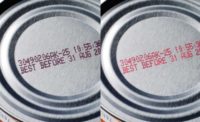Supplier insights
Color spotlight: Going buggy about seeing red

Submitted by Plastics Color
Red is a look-at-me color, whether it’s on a pair of shoes or plastic food packaging. A stimulant to the taste buds, the brain and the emotions, it’s a top choice for advertising, logos and brand identities worldwide. It speaks to us of power and courage, excitement and sensuality. On a label or package, it can stop shoppers in their tracks. The darker the red, the more luxurious the product within, or at least so our brains believe.
A rosy look back
A closer look at red reveals a long and vivid history – and perhaps some interesting facts that may bug you.
First, some science: The human eye perceives red when looking at light between 620 and 740 nanometers. Humans and other primates can see the full spectrum of colors – except for about 8% of men (and 0.4% of women) who have red-green color blindness. Other mammals, including dogs, see blues and yellows, but perceive red and green as shades of gray. The same is true for bulls, which rush the matador because he’s aggressively waving a cape around, not because the cape itself is red. The ability to see red may have been a prehistoric survival skill. Early primates, scientists theorize, developed sensitivity to red so they could distinguish ripe fruit from vegetation that was inedible.
Speaking of prehistory, archeologists have found evidence of early humans grinding ochre, a type of clay that gets its red color from iron oxide, at South African cave sites occupied between 40,000 and 170,000 years ago. The ochre probably was used as body paint, while hematite powder, found at a gravesite near Beijing believed to be nearly 700,000 years old, may have been used to symbolize blood.
Scarlet letters
Fast forward to the early 16th century when Spanish conquistadors brought back a souvenir from the New World that turned out to be as precious as silver and gold: the cochineal bug. A parasitic insect that lives on prickly pear cactus, the cochineal was crushed and dried to produce a red pigment that was more vibrant than anything Europe had ever seen. Used primarily on fabrics at first, cochineal made every other textile dyeing literally pale in comparison. Soon the dried bugs were second only to silver as Spain’s most valuable commodity from the New World.
Cochineal moved beyond the borders of Spain, both in terms of popularity and insect production. But because 70,000 of the tiny bugs were needed to make a pound of cochineal, the price of red clothing was beyond the means of all but the rich and royal. Some societies even regulated who could wear red (or purple), just in case some peasant tried to pass himself off as prosperous. The Catholic Church adopted it as symbol of authority. So did the military, particularly in Britain, where cochineal helped put the red in Redcoats back in the 1700’s.
What delicious yogurt you have
Synthetic dyes began to replace cochineal for textile uses in the 1800’s. The crushed critters still have their uses today though, especially after some artificial dyes in food and cosmetics were found to be dangerous.
Listed on the label as cochineal, carmine, carminic acid, Natural Red 4 or E120, cochineal helps color sausage, artificial crab, pink pastries, dried fish, yogurt, cakes and icings, cookies, pie fillings, ice cream, fruit juices, pills, cough drops, rouge, lipstick, gelatins, candies, shampoos and maraschino cherries. Despite the “ick” factor among some consumers, cochineal is the only natural red food coloring authorized by the U.S. Food and Drug Administration (FDA).
Concentrating on color
On crowded supermarket shelves, color – especially red – makes your product stand out. Studies show that 85% to 90% of shoppers make buying decisions based on color alone, and that color boosts product recognition and fosters brand loyalty.
Experts at Plastic Color’s Solutions Center understand the latest trends in color and how to make them work for your brand. From finding the right color to matching an existing brand identity, Plastics Color offers industry-leading formulations and color concentrates to meet your consumer packaging goals and help you upstage the competition. Contact Plastics Color today for more information, plasticscolor.com.
Looking for a reprint of this article?
From high-res PDFs to custom plaques, order your copy today!





